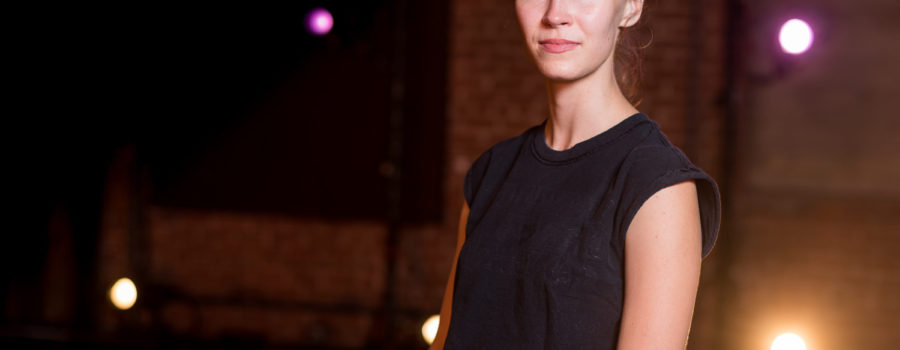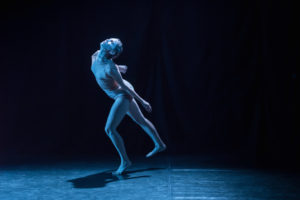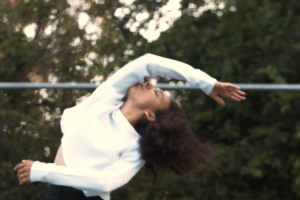A little TBT! We’re re-running last year’s LAX Profile on szalt dance co. choreographer Stephanie Zaletel, written by J. Alex Mathews.
Stephanie Zaletel is a dreamer. She dreams vividly, a lot, and resorts to her body as a vessel with which to better understand the labyrinth of her mind. Zaletel is an instinctual choreographer deeply connected to her own psychology, yet fueled by the creative energy of her collaborators. She treasures the preciousness of the work made with her dance company, “szalt,” but she is also not afraid to abandon all control. What follows is an email exchange between Stephanie Zaletel* and J. Alex Mathews,** a Los Angeles based arts administrator and artist.
AM: I’d like to begin with practice. Having experienced your work many times, including F L W R S and O E (F L W R S remixed), I admire your ability to sustain a practice and generate work regularly. What does rigor look and feel like for you?
SZ: I enjoy long processes. Swimming in my stream of consciousness and exercising material fully. I have always had an active imagination. I dream a lot, and dance is how I analyze my fantasies, paranoia, and demons without overthinking. I crave physical practice and my dancers crave physical practice. Rigor is my default – but rest is equally important. Re-storing, re-generating. Infinite cycles. The work is never finished and always finished.
AM: Collaboration and trust seem to play an integral part in your dance making. You work very closely with a group of women, for example. How do ideas flow from the individual to the collective? And how does audience impact that energy/dynamic?
SZ: It is difficult to explain. I am in love with my team. Each dancer, designer, composer we bring in is incredibly sensitive, driven, and a good match energetically. Serious relationships, rooted in trust and integrity, are critical for me to experience freedom in a process. That said, I learn so much from new voices as well. Bringing in new people and taking our work outside of LA pushes me out of my comfort zone and forces me to trust more willingly.
The work I make is always bigger than individual egos. This kind of agreement takes time, practice, and research. The company members I work with are incredibly brave, hilarious, and honest. This allows me to shed layers, and discover true potential. Camaraderie within the company offers me confidence to bring my work to any audience. If we are all on the same page, audiences trust us. They feel safe watching something a little weird, and enjoying it.
AM: Where did this work begin and what nudged you to stay in conversation with it?
SZ: Wow. It all goes back to about 6 years ago when I was getting my BFA at CalArts. I made a site-specific piece for 7 women on a grassy hill covered in flowers called flowers unfurling. The work reflected a transition into womanhood – one I had difficulty with. I was reading Ulysses by James Joyce at that time and the Penelope excerpt resonated with me more than anything I had ever read in my life. This 700-page novel told through the perspectives of men ends suddenly in 37 pages with a woman’s perspective; she spoke with romance, passion, complexity, sex, love, death, truth, memory, hope…all of it written without punctuation. In the first iteration of my work with flowers – which was made alongside szalt company members Lindsey Lollie and Jordan Saenz while we attended CalArts – I aimed to make work inspired by Penelope’s presence, fueled by my own stream of consciousness, and the collective consciousness of my collaborators.
After graduating I made a new iteration of the piece, flowersallawomansbody. I was interested in flesh in an effort to grapple with sex, social constructs, and personal experiences of physical objectification. Three years after that, F L W R S analyzed and emphasized the stereotypes surrounding feminine growth, love, sex, death, and celebration. To me, in this current revival of F L W R S it’s the deepest we have explored those themes. I am beginning to think that my work with flowers will never feel finished as long as I am alive and a woman.
AM: When do you start to craft creative musings/explorations? What is the interplay between structured choreography and improvisation?
SZ: The process is continuous here too. There is one distilled theme I try to build upon, usually an image, an object, or a dream and then the movement vocabulary of a piece will draw from the physical activities I have in my life at that time: swimming in the ocean, long distance running, playing tennis, hiking, driving, climbing rocks. While my work is categorized as “contemporary dance” we all like to take a cross training approach to our physicality; especially since my work often is not set in a theater, we treat ourselves like athletes – prepared for any and all terrain. I also find it easier to break “dancer” habits if we are running together, swimming, doing yoga, improvising, ballet, etc. A technical foundation is important, but we are also challenging our bodies often and thus unlocking more availability for richer material. During a creative process, my company improvises daily and I set choreography on them regularly. Eventually there is a deadline and the work is considered “finished” for the time being.
AM: F L W R S is described as “demonstrating non-chronological feminine development.” What form does narrative/storytelling take in your work (if any)? How do you invite others into your world?
SZ: I am not a fan of art that tells you how you are supposed to feel. I am not a fan of people who tell you how you are supposed to feel. I am not a fan of advertising that tells you how you are supposed to feel.
A few years ago Julia Planine- Troiani, a dear friend and company dancer would often remind me, “Growth is not always chronological.” I have realized that we continuously connect the dots of who we used to be with, who we are now, who we are going to be, who we want to be, and what we thought would be.
In F L W R S we are trying to connect it all simultaneously for our viewers to digest it at their pace. While there is form to the work and a running order of events, there is not one correct way to experience the work. There are symbols and clues, but what you get from the work is really up to each individual viewer.
AM: What has surprised you? Frustrated you?
SZ: It has been difficult for me to find a balance between exposing my heart and protecting it. Building a dance company versus making enough money to buy groceries and pay rent. Balance is hard to find and fleeting. Through it all I feel so lucky to have such a strong bond with my friends, family, and loved ones. Because of szalt there are more and more beloved people entering my life. That is what it is really all about.
AM: With dance as your primary mode of expression, how does physicality – the physical body – shape and influence your ideas? What do movement, momentum, stillness and everything in between do?
SZ: The body is truly present. The body remembers, even things the mind forgets or suppresses. In my practice, I intend to genuinely listen to my body, challenge boundaries, test physical matter to make room for psychological discoveries and growth.
Szalt’s performances are meditative and oftentimes exhausting or tricky in our effort to make the physical experience human and relatable, instead of entertaining and inaccessible.
AM: What’s next?
SZ: Marshmallow Sea! Marshmallow Sea is a sequel to our most recent creation, WATER STORIES. I am picking up where we left off — examining water symbols, conservation, sustainability, and dream logic. It is scheduled to premier in Seattle in 2017 with Anna Conner at Velocity Dance Center. We will be raising funds in October to create and tour the work. More details soon!
MARSHMALLOW SEA performs at the Bootleg Theater as part of the Los Angeles Exchange [LAX] Festival, 5th ed. Performance times and tickets available HERE.
profile by J. Alex Mathews
portrait by Gema Galiana / La Mujer Tranvía



